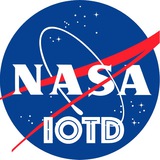When a massive star collapsed in the Cassiopeia constellation, it generated a supernova explosion with some of the fastest shockwaves in the Milky Way. http://www.nasa.gov/sites/default/files/thumbnails/image/casa_streams_lg.jpeg
During its 40th close pass by Jupiter, our Juno spacecraft saw Ganymede cast a large, dark spot on the planet on Feb. 25, 2022. http://www.nasa.gov/sites/default/files/thumbnails/image/pia25015.jpg
This mosaic is composed of images covering the entire sky, taken by the Wide-field Infrared Survey Explorer (WISE) as part of WISE’s 2012 All-Sky Data Release. http://www.nasa.gov/sites/default/files/images/630303main_pia15481c-full_full.jpg
On Oct. 13, 2022, NASA’s Lucy spacecraft captured this image of the Earth and the Moon from 890,000 miles (1.4 million km) away. http://www.nasa.gov/sites/default/files/thumbnails/image/tt1_0718931263_ega1_earth_moon.png
Our James Webb Space Telescope has captured a new image of the famous Pillars of Creation—first imaged by the Hubble Space Telescope in 1995—that reveals new details about the region. http://www.nasa.gov/sites/default/files/thumbnails/image/stsci-01gfnn3pwjmy4rqxkz585bc4qh.png
While observing the outer region of the Milky Way galaxy, our Spitzer Telescope captured this infrared image of a cloud of gas and dust that looks like the hollowed-out pumpkins we see every Halloween. http://www.nasa.gov/sites/default/files/thumbnails/image/jpegpia23403.jpg
Teams at the NASA Armstrong Research Center recently completed stress testing on the Navy’s F/A-18E Super Hornet aircraft, seen here in a top view while in a wing loading test configuration at the Naval Air Systems Command (NAVAIR) in Patuxent River, Maryland. http://www.nasa.gov/sites/default/files/thumbnails/image/afrc2022-0025-003large.jpg
Since 2015, scientists participating in NASA’s Arctic Boreal Vulnerability Experiment (ABoVE) have been studying the impacts of climate change on Earth’s far northern regions and how those changes are intertwined. http://www.nasa.gov/sites/default/files/thumbnails/image/img_9868.jpeg
Selected as an astronaut candidate in June 2013, Nicole A. Mann is the first Native American woman from NASA in space. http://www.nasa.gov/sites/default/files/thumbnails/image/43825570281_3f9794b07a_o.jpg
NASA’s Space Launch System (SLS) rocket with the Orion spacecraft aboard was seen lit by spotlights atop the mobile launcher at Launch Pad 39B as preparations for launch continued Sunday, Nov. 6, 2022, at NASA’s Kennedy Space Center in Florida. http://www.nasa.gov/sites/default/files/thumbnails/image/52481756807_f1d16d6418_o.jpg
This composite made from ten images shows the progression of the Moon during a total lunar eclipse above the Vehicle Assembly Building, Nov. 8, 2022, at NASA’s Kennedy Space Center in Florida. http://www.nasa.gov/sites/default/files/thumbnails/image/52486072251_b8254d9621_o.jpg
In this image from June 24, 2022, NASA astronauts Jessica Watkins and Bob Hines work on the XROOTS space botany investigation, which used the International Space Station’s (ISS) Veggie facility to test soilless hydroponic and aeroponic methods to grow plants. http://www.nasa.gov/sites/default/files/thumbnails/image/10_iss067e149651_watkins-hines.jpg
Jerry Elliott, a former NASA physicist and one of the first Native Americans hired at NASA's Johnson Space Center, speaks during Native American Heritage Month event in 2017 at NASA's Marshall Space Flight Center. http://www.nasa.gov/sites/default/files/thumbnails/image/msfc-1701440_orig.jpg
The Moon makes a stunning backdrop for the successful launch of the third in a series of polar-orbiting weather satellites for the National Oceanic and Atmospheric Administration (NOAA) and our Low-Earth Orbit Flight Test of an Inflatable Decelerator (LOFTID) on Nov. 10 at 1:49 a.m. PST from Vandenberg Space Force Base in California. http://www.nasa.gov/sites/default/files/thumbnails/image/52489574532_dc6bc4a5f7_o.jpg
🔥2
The Moon is seen rising above NASA’s Space Launch System (SLS) rocket with the Orion spacecraft aboard at Launch Pad 39B as preparations for launch continue, Monday, Nov. 14, 2022, at NASA’s Kennedy Space Center in Florida. http://www.nasa.gov/sites/default/files/thumbnails/image/52501183334_08fafd4729_o.jpg
Our Space Launch System (SLS), the most powerful rocket in the world, carrying the Orion spacecraft launches on the Artemis I flight test, Wednesday, Nov. 16, 2022, from Launch Complex 39B at NASA’s Kennedy Space Center in Florida at 1:47 a.m. EST. http://www.nasa.gov/sites/default/files/thumbnails/image/52503823645_68f1fc0f28_o.jpg
Stephanie Yazzie, Northern Arizona University student and NAU Space Jacks team member, poses with her team’s rocket in this photo from the 2019 NASA First Nations Launch (FNL) competition. http://www.nasa.gov/sites/default/files/thumbnails/image/dsc06042.jpg
A small, dense cloud of gas and dust called CB 130-3 blots out the center of this image from the NASA/ESA Hubble Space Telescope. http://www.nasa.gov/sites/default/files/thumbnails/image/hubble_cb130-3_potw2246a.jpg
On Nov. 20, the fifth day of the 25.5-day Artemis I mission, a camera mounted on the tip of one of Orion’s solar array wings captured this footage of the spacecraft and the Moon as it continued to grow nearer to our lunar neighbor. http://www.nasa.gov/sites/default/files/thumbnails/image/cmasaw1_20221120192424.jpg
NASA’s uncrewed Orion spacecraft snapped this black and white photo of Earth on Nov. 17, 2022, the second day of the 25.5-day Artemis I mission. http://www.nasa.gov/sites/default/files/thumbnails/image/fd2_opnav_art001e000013_orig.jpg
